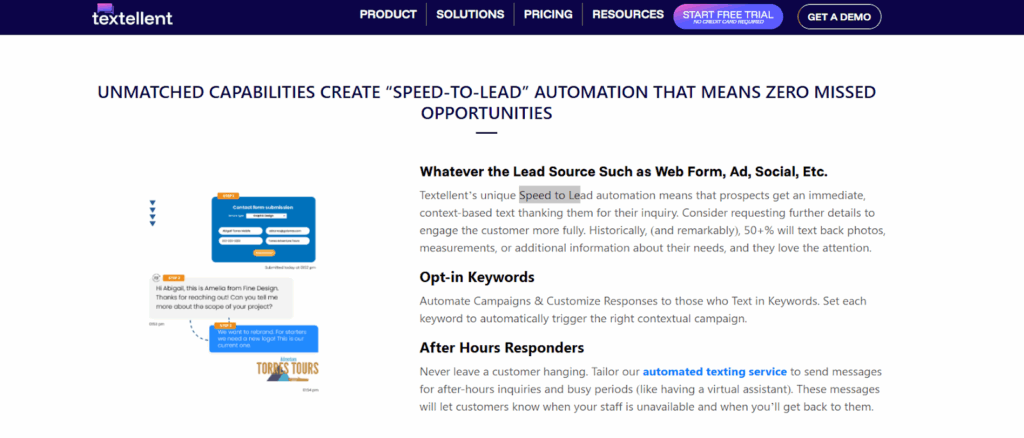
How to Gain a Competitive Edge With Speed to Lead Tactics
Speed to lead helps you reach new contacts before their interest fades. But many teams struggle with this first step.
Leads come in at all hours, reps get busy, and messages pile up before anyone notices them. These small bottlenecks could stack up and turn warm contacts into lost chances.
A better approach starts with fixing the weak points that slow your team down. Once you understand where delays happen, it becomes easier to tighten your lead response process.
In this article, we will look at practical speed-to-lead tactics your team can use right away. We will uncover where delays happen and how an SMS marketing platform helps keep qualified leads engaged from the beginning.
Why a Slow Start Hurts the Whole Sales Path
Speed to lead is the short window between the moment a prospect fills out a form and the moment a team reaches out.
But most businesses lose deals because they reply too slowly. The gap between interest and contact is where the lead decrease sets in.
A slow opening can impact sales performance because that delay weakens the early flow of the sales funnel, and fewer inbound leads stay warm long enough to move forward.
According to LeadResponseManagement, the chance of turning a lead into a real talk drops about 21 times when the reply window grows from five to 30 minutes. This sharp drop shows how fast the window closes.
Even small delays hurt. The same study showed that moving from a five-minute reply to a ten-minute reply cuts the chance of qualification by about four times. That kind of falloff happens long before price, features, or timing come into play.
SMS marketing helps sales representatives avoid those drops because texts reach people right away. A short message reaches fast and does not demand much effort from the lead. It also works well for people who ignore calls or skim emails.
Instead of waiting for a rep to catch up, a quick text gives a light first touch that keeps the door open. This small shift helps hold the lead’s expressed interest until a rep steps in.
That alone can make all the difference when your goal is to engage prospects and protect early contact and conversion rates.
How SMS Supports Faster Lead Movement
Most leads check their phones many times a day, so a text lands right when interest is fresh. This makes SMS useful for capturing leads at the exact moment they are paying attention.
SMS should sit at the front of your speed to lead plan because it reaches people faster than any other channel. Speeding up your response time through texting helps improve sales success, especially when you use the right automation tools instead of leaning on slow processes.
Below are the reasons why quick SMS contact matters for your operations and your lead metrics:
Increased Engagement
Quick responses can turn potential interest into actual sales. When questions get answered fast, the lead is less likely to drift away or check out other options. It helps hold their focus and makes them more likely to reply.
Early customer engagement also supports smoother lead follow-up and keeps prioritizing high-potential leads manageable for reps.
Textellent keeps your replies quick, your leads warm, and your team ready at the right moment.
Sign up for a free trial or request a demo consultation and see how faster engagement can lift your entire flow!
Higher Conversion Rates
Instant responses can turn potential interest into actual paying customers. When questions get answered fast, the lead is less likely to drift away or check out other options.
Texts also feel simple to reply to, so the lead takes the next step right away. This lifts your overall lead conversion rates without adding extra pressure on sales teams to chase cold contacts.
Competitive Advantage
Fast responses are often seen as a reflection of strong internal structure and clear communication.
When potential customers receive quick text replies, they interpret it as a sign that your business values their time and needs. It makes a big difference when they send a demo request or use their job title to seek info.
Immediate replies preserve the momentum of interest. This can influence their readiness to purchase and may lead to more sales in a shorter timeline.
Builds Loyalty and Trust
Fast SMS replies show reliability. When leads see that your team responds without delay, they feel more comfortable asking questions or sharing details.
Trust helps you engage leads consistently and gives you space to use lead enrichment later in the process. It also supports a cleaner follow-up process because leads know you will be there when they reach back out.
Improved Customer Experience
SMS can help boost customer satisfaction, keep lead distribution more organized, and reduce lead recycling since fewer contacts fall out of the process.
Happy customers are more likely to return and recommend your business through word of mouth or Google reviews. This can improve your reputation and also attract new customers.
How to Improve Your Speed to Lead Strategy
When your process supports quick replies, leads hear from you at the moment their interest is strong. Here’s how to build a setup that supports quick timing from the first touch onward.
Build a Solid Lead Routing System
A good routing setup keeps reply times short by sending each new lead to the right rep.
Routing also helps your teams during busy hours. A clean setup that moves each lead to the next available rep keeps the load from piling up. It keeps reply times tight even when volume rises.
It also cuts down on mix-ups. When leads land with the incorrect rep or in the wrong stage, the team loses time sorting things out. Those extra minutes can cost the chance at a real talk and lower your lead quality at the earliest stage of contact.
Automate First Touchpoints
Many delays happen before a rep even sees the new contact, so using an SMS automation tool ensures instant replies to new leads.
The system automatically sends a reply when someone reaches out, whether through a form on your website, an email, or a direct message on social media.
As soon as someone shows interest in your service or product, automated text messages make sure they’re not left waiting. The idea is not just speed but also giving people an immediate response.
A short message gives the lead a sense of motion and stops the early drop-off that often happens when nothing happens after a form fill. SMS autoresponders are also helpful during off-hours or busy bursts when reps cannot reply right away.
Short texts or emails built into the system can also guide leads toward the next step. This could be a simple thank-you message, an expectation of when a rep will reach out, or a note asking a quick question to keep the lead active.
Set Up Real-Time Lead Notifications
If new leads sit in an inbox or in a hidden corner of the CRM, reps often find them too late to get a good response.
Notifications that pop up the moment a form is sent, a call is missed, or a chat comes in make it far easier for someone on the team to act right away.
These alerts can show up in tools that reps already use during the day, like email, chat apps, or mobile push messages.
For example, a rep might get a mobile alert the moment a new form is submitted, with the lead’s name, contact details, and basic context included. That way, they can reach out while the person still has the page open or the question fresh in their mind.
Good alerts also include enough info to help reps act fast. Adding source, time of form fill, and what the person asked for lets the rep send a customized reply. This cuts out back-and-forth to figure out what the lead wanted in the first place.
Create a Lead Ownership and Handoff Process
A simple rule that assigns each new contact to one rep right away keeps the first step tight. The goal is to remove any moment where a lead sits untouched because the team is guessing who should take it.
A smooth handoff also matters once the first rep makes contact. If the lead needs to move to another rep or a different team, that shift should be quick.
Slow handoffs often lead to long pauses, mixed messages, or two reps speaking to the same person without knowing it.
To make this work, each handoff should include full context: what the lead asked for, what the rep learned, and what the next step should be.
When the next rep has all the info in one place, they can step in without asking the lead to repeat themselves. This saves time and helps the new rep start the talk with more confidence.
Prioritize Leads With Smart Segmentation
Smart segmentation helps teams reply faster by sorting leads into clear groups based on intent, timing, and past actions. When leads are grouped with simple rules, reps can focus on the contacts most ready to talk instead of spending time sorting through every new form fill.
Pre-qualifying leads typically involves gathering initial information from potential customers through forms, quick surveys, or initial interactions. Once you identify which leads are well-aligned with your offerings and ready to decide, you can prioritize these interactions.
You have to know which leads are more likely to convert so that you can allocate your team’s time and resources better. Instead of spending equal time on every inquiry, your sales team can nurture and route leads with higher conversion potential.
One of the standout features of Textellent’s segmentation system is its powerful tagging feature, which makes segmenting and sending texts even more effective.

With SMS segmentation, you can assign tags to your contacts based on various characteristics. Once these tags are in place, creating and sending micro-targeted campaigns becomes easier.
Score Leads to Prioritize High-Intent Prospects
When a person fills out a form, clicks a link, replies to a text, or spends time on a key page, these actions can raise their score.
Lead scoring works best when the rules are easy to follow. Points can come from the type of form filled out, the number of pages viewed, or the choice of meeting times.
A clean scoring method supports smoother lead management so reps can decide where to focus time and who to approach first.
Some signs carry more weight than others, such as a strong question, a clear goal, or a request for details. You can sort contacts with steady rules, giving reps a clearer view of who might be ready for a quick first touch.
Leverage CRM Tools
CRM tools help you track where each prospect is in the sales process and the source of the lead. When you understand potential customers’ journey, you can target your sales pitches better and close more deals.
An SMS-ready CRM helps teams keep reply times short by placing all lead details and text history in one spot. When a new contact enters the system, the rep can see form info, past actions, and any text replies the person has already sent.
SMS inside the CRM also helps teams keep track of every message without losing context. Each reply, link click, or question from the lead appears in the record. This allows the rep to understand the lead’s mood and interest level before reaching out again.
Schedule Follow-Up SMS
Scheduled texts help teams stay close to leads without losing time or missing key moments. It supports a healthier lead response time because it keeps new contacts from waiting too long between touches.
Many contacts do not reply on the first try, even if they are interested. A simple follow-up text can bring them back into the conversation and help you track performance across your early touchpoints.
You also have to determine the best time to send your text messages based on the lead’s previous interactions. Timing matters because it can affect contact rates and help your team avoid unnecessary contact attempts.
For example, if a lead inquires about a product, but doesn’t make a decision, schedule a follow-up SMS a few days later to ask if they have any questions or need further information. Timing these messages can increase their effectiveness.
You can use an automated text message service like Textellent to schedule these campaigns and determine the cadence in advance. SMS automation reduces the amount of manual data entry for your reps and keeps conversations moving.
Keeping your prospects engaged is key to converting leads into loyal customers. Textellent’s SMS drip campaigns allow you to set up a series of automated messages sent out at predetermined intervals.
This method helps you keep in constant touch with your prospects without overwhelming them.
Reduce Steps in Contact Forms
When a form asks for too much info, many leads stop halfway, lose focus, or leave the page. Cutting out extra fields keeps the process simple and helps teams get more contacts without adding more traffic.
Fewer steps also help leads move from curiosity to contact faster. When the entry point is easy, leads complete the process more often, giving teams more chances to reach out while interest is fresh.
SMS marketing fits well with short forms because teams can gather extra details later through a quick text.
Instead of forcing everything into the form, reps can send a brief message asking for one or two key details right after the submission.
Most people find it easier to reply to a text than to fill out ten fields online, which helps maintain a steady average response time.
Use Templates and Scripts to Respond Faster
When reps have a set of simple templates for common moments like new form fills, missed calls, or early questions, they can reach out right away without stopping to think about wording.
Templates also help keep the tone the same across the team. When every rep starts with simple lines, leads get a smooth experience no matter who handles the first touch. This avoids long pauses where a rep tries to craft the perfect message.
Recommended Reading
Sales Text Message Examples: 15+ Templates That Drive Results
Appointment Reminder Template: Examples + Types
Use the Right Tool for Lead Engagement
Texting allows you to contact leads instantly. Compared to emails, which sometimes sit unread in an inbox, SMS messages typically get read within minutes.
SMS business solutions like Textellent can send instant replies to inquiries even when your sales rep is busy or out of the office. You can schedule follow-up messages that keep the conversation going.
With its Speed to Lead feature, Textellent improves your ability to respond quickly to leads and help pre-qualify them. This automated texting service allows for automated SMS campaigns that are ideal for engaging early with potential customers.

This sales engagement platform also allows follow-up texts to be scheduled through its platform, and for scheduling appointments with prospects, it can even be linked to your existing scheduling system.
It invites prospects to self-book consultations or meetings and receive meeting reminders to transition from initial contact to deeper customer engagement.
Bring More Leads Into Real Conversations—Start Texting With Textellent!
A slow reply can cost you the conversation before it even starts. Textellent helps your team act the moment a new contact reaches out, so you never lose that early spark of interest.
A fast text meets the lead at the exact time they want to hear from you, and that simple step can shape the whole conversation.
With Textellent, your reps get instant alerts, quick-send text options, and lead details all in one place. This setup helps your team move the second a form comes in, hold the lead’s attention, and guide more contacts into real conversations.
If you want more talks, more booked calls, and fewer missed chances, Textellent is built for that. You can bring speed to lead into your daily flow and keep every new contact warm while the interest is high.

A stronger speed to lead plan starts with the right texting tool, and Textellent gives your team that edge. Don’t let slow responses be the bottleneck in your business growth.
Sign up for a free trial or request a demo consultation today to see how Textellent can support your business revenue growth!
FAQs About Speed to Lead
What does speed to lead mean?
Speed to lead is the time it takes for a team to reach out after a person shows interest. It starts the moment a form is sent, a call is made, or a message is submitted.
The shorter this gap is, the easier it is to start a real conversation while interest is still fresh. Strong timing also supports better lead capture, since contacts are reached while they still remember taking action.
What is the five-minute lead rule?
Early timing is a critical factor in how smoothly someone moves into the sales cycle. The five-minute rule means teams should reach out within 5 minutes of the form fill.
After this point, interest drops fast, and response rates fall. A short reply window keeps the lead warm and makes the next step much easier.
What is the study on speed to lead?
A Harvard Business Review research found that contacting a new lead within an hour made companies nearly 7x more likely to qualify that lead.
But there’s newer data that points in the same direction and even stronger. A 2025 Speed to Lead report shows that answering within 1 minute makes you 7 times more likely to qualify a lead than replying after 30 minutes.
This set the foundation for understanding how timing shapes the first conversation and how slow replies can raise agent talk time later in the process.
How important is speed to lead?
Speed to lead matters because people lose interest quickly when they do not hear back. A fast first touch builds trust, while a slow one makes the lead consider other choices.
If you reply right away, you’ll gain more booked calls and fewer missed chances. It helps you reach leads quickly and create a smoother flow, allowing sales teams to stay in front of new interest.
Fast timing also provides valuable insights, strengthens your key metrics, and shows where you are improving speed across your early touchpoints.





